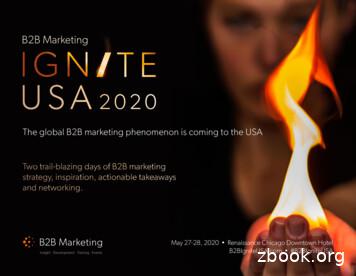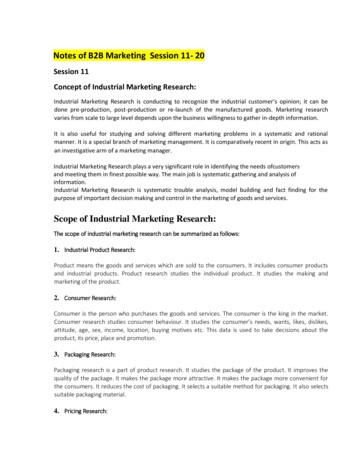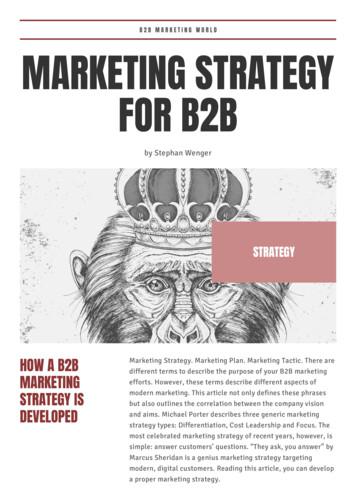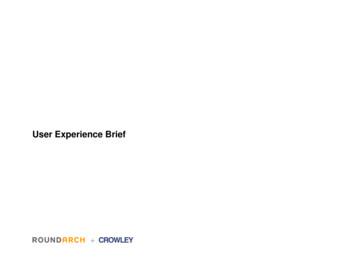B2B Customer Experience Benchmark
B2BCustomerExperienceBenchmarkReport 2016From Content to Revenue:Original Research on theMarketing-Driven Customer Experience
Great Customer ExperiencesDrive Revenue
Delivering a great customerexperience is critical to thesuccess of B2B organizations.In the Age of the Customer, B2B buyers are in control of theirown purchase process—from evaluation through upsell andrenewal. Instead of picking up the phone to request informationon a company and its products, today’s customers conductthe majority of their research online. These tech-savvy buyershave high digital expectations and are unlikely to completea purchase after a bad interaction or experience, even if thatcompany has the best product on the market. However,organizations that provide consistent, compelling interactionsacross the customer journey stand to win the business—andloyalty—of these buyers.3In short, great customer experiences drive revenue.
But the term “customer experience” is elusive. Customerexperience encompasses each interaction between a customerand brand across channels (social media, website, email, sales,etc.) and technologies (marketing automation, CMS, CRM, etc.).The B2B buyer’s journey is often long and complicated, and intoday’s overwhelmingly digital and customer-driven landscape,the number of touch points from awareness to purchase hasincreased exponentially. To add to the difficulty, differentchannels, tools, and data points are managed by siloed teamswithin a single organization.4In this survey, only 12% of B2B marketers rate themselves as“very effective” at delivering a great customer experience.
Learn MoreThe B2BMarketer’s Guideto Managing CXWhy? Managing—not to mention optimizing—the puzzle thatis the B2B customer experience is complex, and deliveringconsistency requires organizations to establish alignment andvisibility across departments and functions.Get your copyof The B2BMarketer’s Guide toManaging CustomerExperience, andlearn how to createa marketing-drivencustomer experiencethat drives businessgrowth for yourorganization.However, defining ownership of the customer journey is still awork in process. The majority of respondents think marketing isresponsible for the end-to-end experience, but some marketersstill feel that sales, customer support, or a dedicated CX teamown the job.Get your guideWhen analyzing how the customer experience is defined,delivered, and tracked, content is the unifying piece ofthe puzzle. It’s B2B marketers who oversee the entire contentlifecycle, from strategy through optimization.5
Yes, content is still king. 81% of marketers invest in contentmarketing, making it the top marketing investment of 2016.Also, 85% of B2B marketers agree that consistency acrosscontent, teams, and channels is the backbone of aneffective customer experience, and the majority of marketersinvest in marketing technology to support their efforts.Furthermore, the increasing importance on investmentin content has firmly established marketing as a revenuegenerator, a hard contrast to the age-old perception ofmarketing as a “cost-center.” And marketers are embracing thisrole—lead generation and revenue/ROI are ranked as the topmarketing priorities of 2016.If content is the backbone of an effective B2B customerexperience and businesses continue to invest in content, whyare some B2B marketers falling short?85% of B2B marketers agreethat consistency across content,teams, and channels is thebackbone of an effectivecustomer experience6
The top three barriers to successfully delivering a consistent andeffective customer experience are: Inefficient internal processes Tracking and reporting the right metrics Lack of alignment across internal teamsInefficient processes and lack of insight into metrics block B2Bmarketers from optimizing the customer journey and meetingtheir goals.In this report, we examine the key drivers of effective B2Bcustomer experience and the major barriers to success.This research serves as a benchmark for B2B marketers,providing insights for improvement in alignment, execution,distribution, and optimization of the content and programs thatpower the customer experience.7
Table of Contents The Methodology: Benchmarking B2B Customer Experience Key Findings and Analysis Takeaways The State of B2B Customer Experience The Key to Success: Connect Content to Revenue Overcoming Barriers: People, Process, and Technology8
The Methodology:Benchmarking B2BCustomer ExperienceIn Q1 of 2016, Kapost conducted an online survey to identify andbenchmark the key indicators of B2B customer experience success.This report examines the marketing trends, tactics, andtechnologies that drive an effective customer experienceas well as the major barriers to success.To explore the tactical and granular aspects of the B2B customerexperience, the remainder of this report delivers analysis fromthe filtered survey population. Here’s how it breaks down:9
Total SurveyRespondents: 316286 B2B Marketing Respondents:73%B2B27%BothWhich of the following best describes your orHow effective is your marketing organization atdelivering a consistent customer experience?Top performers12%55%Very effectiveSomewhat effective1028%Not very effective5%Not at all effective
Key Findingsand Analysis
Undoubtedly, adapting to the digital transformation anddelivering a consistent, effective customer experienceis imperative to B2B success, but for the majority of B2Bmarketers, execution is still in its infancy.The pressure to move away from the traditional sales funnelideology and embrace a more holistic view of the customerjourney is intensifying. While the majority of B2B organizationshave shifted from product-centric to customer-centric content,content is still created reactively. A lack of process for crossfunctional collaboration and alignment has placed great,marketing-driven customer experiences just out of reach.85% of B2B marketers agreethat consistency across all contentis the backbone of an effectivecustomer experienceThe good news: there’s a clear path to success.Only 12% of B2B marketersconsider their marketingorganization “very effective”at delivering a consistentcustomer experience12
B2B marketers resoundingly agree (85%) that consistencyacross all content is the backbone of an effective customerexperience. However, many B2B marketers still struggle toalign, execute, distribute, and optimize targeted content—only39% of survey respondents have a documented buyer’s journeythat allows them to identify gaps in content targeted at specificstages. Also, only 41% agree or strongly agree that theirteam is truly data-driven, focusing resources on the mosteffective content, channels, and initiatives across the customerexperience.Before marketers can begin to optimize the customerexperience, a comprehensive view of content within theorganization is absolutely critical: 83% of top performershave a documented CX strategy in place. Understandinghow content guides the buyer’s journey, establishing tightinternal alignment, and tracking the right performance metricsare the keys to successfully delivering an effective customerexperience.13
Takeaways12%Onlyof B2Bmarketers rate themselvesas “very effective” at delivering aconsistent customer experienceInefficient internalprocesses, tracking andreporting the right metrics,and lack of alignmentacross internal teams are theLead generation and revenue wereranked as the top two marketingpriorities, yet only 41% ofB2B marketers considertheir organization to betruly data-driven85% of B2B marketerstop three barriers to successagree that consistency across content,teams, and channels is the backboneof an effective customer experience83% of top performerstake a buyer-centric approach to contenthave a documented CX strategy inplace80% of respondentswho ranked themselves as “veryeffective” or “somewhat effective”at delivering a consistent customerexperience have a process forinternally crowdsourcing ideas,compared to only 40% ofrespondents who rankedthemselves as “not very effective”or “not at all effective”56% of B2B marketersare directly responsible for revenueat their organization75% of B2B marketers92% of top performershave a shared editorial calendarfor planning marketinginitiatives, compared to 11% ofrespondents who are “not atall effective”56% of B2B marketersdon’t feel like they have visibilityinto initiatives, timelines, anddeliverables across teamsTop performers are over 3Xmore likely to have visibilityinto initiatives, timelines, anddeliverables across teams
The State of B2BCustomer Experience
63% of top performershold marketing responsible for managingthe overall customer experience63%B2B marketers understand the impending significance ofdelivering consistent customer experiences, and the majorityof marketers are rising to the occasion. Nearly two-thirds (63%)of top performers hold marketing responsible for managing theoverall customer experience.However, many feel that customer experience is a companywide effort. Twenty-nine percent (29%) of respondents indicatethat everyone is responsible for managing customer experience.This makes sense, as nearly every function of a businessinteracts with customers in some way.16
29% of respondentsindicate that everyone within anorganization is somewhat responsiblefor managing customer experienceThe cross-functional nature of customer experience forcesmarketing organizations to rethink how they work andcollaborate across teams and departments.17
Managing the End-to-EndCustomer ExperienceIt comes as no surprise that marketing is the forerunner formanaging the end-to-end customer experience. Since the dawnof digital disruption, marketers have reinvented how to market,picking up new skills, tools, and technologies along the way.As the owners of digital channels and the content that fuelsthese channels, marketers already have an acute awarenessof buyer preferences. In assuming responsibility over thecustomer experience, the greatest challenge marketers faceis managing consistency in messaging across their entireorganization, including hand-offs, as customer interactionsmove from marketing to sales to success and support teams.Is your marketing organization responsiblefor managing the customer edicated CXManagement n customersuccess andsupport, marketing,and sales.”“No one, andthe effort isfragmented.”“Everyone.”
Marketing-Driven CustomerExperiences Are More EffectiveOnly a small margin of B2B marketers rank themselves “veryeffective” at delivering consistent customer experiences, butthe majority of “very effective” and “somewhat effective”marketers are responsible for managing the end-to-endexperience.How effective is your marketingorganization at delivering a consistentcustomer experience?Veryeffective12%63% of top performers are responsible for managing customer experienceSomewhateffective55%65% responsible for managing customer experienceNot veryeffective28%44% responsible for managing customer experienceNot at alleffective5%44% responsible for managing customer experienceFurthermore, 67% of top-performers agree that marketingdriven CX has improved their lead quality.19
What’s even more telling is that 78% of respondents who rankthemselves as “not at all effective” are also not responsiblefor managing customer experience. These insights tell us thatwhen marketing teams are empowered to take the reins on CX,they are much more likely to deliver it effectively.Since adopting marketing-driven customerexperience, lead quality has increased.47%9%StronglyagreeAgree67%Strongly agree or agreeVery effective2035%8%DisagreeNotapplicable78%Not applicableNot at all effective
The Key to Success:Connect Content to Revenue
The Key to Success:Connect Content to RevenueWhen it comes to delivering and optimizing great customerexperiences, B2B marketers are focused on two things: contentand revenue. 81% of survey respondents reported contentmarketing as a top investment in 2016. Lead generation,revenue/ROI, and brand awareness ranked as the top threemarketing priorities. This data shows marketers are thinkingmore strategically about the role of content and its impact onbusiness growth.22
Which marketing programs areyou investing in this year?81%Content marketing64%Social marketing50%Events50%Inbound marketing50%SEO/SEM49%Digital advertising33%Account-based marketing (ABM)30%Customer advocacy26%Data integration20%Referral marketing17%Print advertising16%Post-sale marketing14%Agile marketingWhat are your top three marketing priorities?2348%67%Revenue/ROILead generation47%Brand awareness
Consistency across Content Is KeyContent drives great customer experiences and executivesagree—82% of C-level survey respondents say thatconsistency across content, teams, and channels is thebackbone of an effective customer experience.Consistency across content, teams, and channels isthe backbone of an effective customer experience.41%Strongly agree45%10%AgreeDisagree5%Strongly disagreeKey internal stakeholders agree that inconsistencyacross content and messaging has a negativeimpact on the customer experience23%Strongly agree52%Agree22%Disagree4%Strongly disagreeConsistency across content is the final milestone marketersshould aim to achieve to successfully deliver an effectivecustomer experience. But first, B2B organizations have a lotof work to do to overcome process inefficiencies and internalmisalignment, the two biggest barriers to content consistency.24
Revenue Is a Priorityfor B2B MarketersWith content ranked as the top investment, and lead generationand revenue/ROI as the top priorities, marketers understandthat content serves the entire buyer’s journey, and they areeager to know content’s impact on revenue.More than half of B2B businesses hold marketing accountable torevenue and with good reason—70% of marketers responsiblefor revenue at their organization met or exceeded their revenuegoals.Is marketing directly responsiblefor revenue at your organization?70%of marketersresponsible forrevenue met orexceeded theirrevenue goals56%44%NOYESInterestingly, 19% of survey respondents that self-reported asdirectly responsible for revenue didn’t have measurable goalsin the last year. This nuance alludes to the fact that tracking andreporting the right marketing metrics is still a huge barrier thateven revenue marketers and top performers haven’t completelyfigured out.25
Content Conversions Arethe Most Important MetricsContent conversions between sales stages are the mostimportant metrics to measure for a complete performancereview of the end-to-end customer experience. Marketingorganizations that have the right infrastructure to accuratelytrack content conversions at every stage of the buyer’s journeyhave a clearer view of how content works and are betterpositioned to identify opportunities for optimization.Which metric is most important to you?“Revenue.”44%Contentconversionsex: conversionsbetween salesstages, chmetricsex: engagement,traffic bychannel, etc.ex: number ofinternal views,shares, anddownloads ofcontent“Pipelinegenerated forevery dollarinvested.”6%Productionand efficiencyinsights6%OtherUnderstanding how content impacts business metrics (i.e.revenue) and getting a clear picture of the content that drivesresults are critical for organizations aiming to deliver, measure,and optimize great customer experiences.26
Overcoming Barriers:People, Process, and Technology
Overcoming Barriers:People, Process, and TechnologyWe’ve identified the elements of a successful customerexperience strategy—marketing-driven, consistent acrossall content, and trackable—so let’s take a closer look at theobstacles to success.B2B marketers report inefficient internal processes,inadequate data insights, and lack of alignment across internalteams are the greatest barriers to delivering effective customerexperiences.28
Managing the B2B customer experience isn’t easy. It requiresa complete shift in thinking about the role of marketingwithin an organization. B2B marketers understand the needsof their customers and the strategies and tactics to deploy,but execution falls flat due to siloed teams, channels, andtechnologies.What are your greatest barriers to success?49%42%Tracking and reporting the right metrics34%Lack of alignment across internal teams33%Sales/marketing alignment26%23%14%Inefficient internal processesLack of consistency across channelsThe perception of marketing within the organization(i.e. see marketing as cost center vs. revenue generator)Lack of visibility into marketing/business plans11%Other“Scaling our marketing process.”“Lack of an integratedcontent management tool.”Execution falls flat due tosiloed teams, channels,and technologies29
B2B Marketers Are Eagerfor Visibility and AlignmentMany B2B marketers still live in the content chaos stage of thecontent maturity model. In this stage marketers struggleto execute a marketing strategy and an aligned customerexperience due to siloed departments and missed hand-offsbetween teams.Two of the three highest ranking barriers to success—inefficientinternal processes and lack of alignment across teams—directlyaddress the need for an updated system that facilitates crossfunctional collaboration. Outdated, siloed organizationalstructures simply do not support effective customer experiencestrategies.Top performers are more than3X more likely to have visibilityinto initiatives, timelines, anddeliverables across teams30
We have visibility into initiatives,timelines, and deliverables across p performers75%14%Agree or strongly agree42%Not at all effectiveAgree22%Agree or strongly agreeSome marketers have made calculated strides to attain greatervisibility and alignment within their organization—75% of topperformers report having visibility into initiatives, timelines,and deliverables across teams. These top performers are also 2Xless reactive about content creation than respondents who selfreport as “not effective.”Visibility makes planning ahead not only possible but alsoefficient. Internal content consumers and creators can find anduse content, senior-level marketers can see how campaignsare tracking toward completion, and teams can avoid workingreactively or creating ad-hoc content.31
Alignment across TeamsOnce visibility is achieved, teams can plan cross-functionally toalign their content, people, and initiatives to a unified strategy,shared business objectives, and revenue goals.To deliver effective customer experiences, different teamsmanaging content through various channels and technologies ateach stage of the buyer’s journey need to tell a consistent story:“Customers are exposed to the content they are exposed to.They don’t care what department created it and they don’t care ifsales and marketing are misaligned. They really are just frustratedbecause they are looking for information and not able to find it.When they find it, it’s incongruent.”—Scott Abel, Global ContentStrategist, “How Content Creators Burn Money: An Interviewwith Strategist Scott Abel”Marketing organizations thatare strongly aligned with sharedbusiness objectives are 3X morelikely to be effective at deliveringconsistent customer experiences32
Marketing organizations that are strongly aligned with sharedbusiness objectives are 3X more likely to be effective atdelivering consistent customer experiences, and 83% of topperformers have a documented customer experience strategy.The marketing organization is tightlyaligned to shared business sagreeTop performers9%53%22%75%Agree or strongly agreeNot at all effective22%Agree or strongly agreeWe have a documented strategy in place fordelivering a consistent customer agreeTop performers%% 743%83%36%Agree or strongly agreeNot at all effective0%Agree or strongly agree33
Planning: Mission Criticalfor B2B MarketersA documented strategy is critical to delivering a consistentcustomer experience—83% of top performers have adocumented strategy, compared to 0% of those whorated themselves as “not at all effective.” And marketingexperts agree:“As you start adding in different product groups, regional offices,functional elements—basically, as the enterprise gets larger—theprocess becomes more complex.Those that are actually creating awritten strategic document for the management of their content arethose that are succeeding with it. Maybe that sounds like a ‘duh.’ It’ssuch a simple thing, but so important. It makes it a real function ofthe business.”—Robert Rose, Content Marketing Institute,Planning Problems May Be Where Your Content Crumbles:An Interview with CMI’s Robert Rose”Developing a customer experience strategy is a concertedeffort. The only way to deliver a great customer experienceis to strategize around the perspective of the customer asthey move from one touch point to the next. However,each stage of the buyer’s journey is likely managedand tracked by different teams, and even differenttechnologies.34
In order to plan an effective strategy, B2B organizationsneed to enable internal stakeholders to align, track, andcollaborate on content in a centralized location.Plan, Track, and Collaborate on Content All in One PlaceKapost B2B marketing platform is the only solution that allows you to align,execute, distribute, and optimize your entire B2B customer experience.Learn MoreWe have an established feedback looparound shared objectives and data e6%34%14%Top performers71%Agree or strongly agree46%Not at all effective0%Agree or strongly agree35
When we dig deeper into the difference between topperformers and all respondents, clear patterns emerge.Only 57% of total respondents have a shared editorialcalendar for planning marketing initiatives, comparedto 92% of top performers. A shared editorial calendar iscritical to align internal teams around marketing content,campaigns, and initiatives.Do you have a shared editorial calendarfor planning marketing initiatives?92%YESVery effective63%35%YESYESSomewhat effectiveNot very effectiveNot at all effectiveYES11%Do you have a process for crowdsourcingideas across your organization?59%3622%YESYESVery effectiveSomewhat effective29%11%YESYESNot very effectiveNot at all effective
More Efficient Processesfor Collaborative ExecutionThe number one roadblock to delivering consistent andeffective customer experiences is a lack of internal processes formanaging content across the content life cycle.Marketers who ranked themselves as “not effective” haveneither a unified strategy nor clear business objectives. Becauseof this lack of planning and foresight, execution of contentfalls short. 77% of “not effective” marketers feel reactive toimmediate needs, leading to ad hoc content creation—morethan half reported that they often experience missed hand-offsbetween internal teams leading to delays in execution.Top performers are nearly 2Xless likely to feel reactive andad hoc about content creation37
We are often reactive to immediate needs, leadingto ad hoc content creation and duplicative sagree49%25%Top performers33%Agree or strongly agreeNot at all effective77%Agree or strongly agreeThere are often missed hand-offs betweeninternal teams that lead to delays in ee8% 11%45% 36%Top performers25%Agree or strongly agreeNot at all effective55%Agree or strongly agree38
A Centralized, SingleSource of ContentStrategic distribution of content shapes the customer experience.“Quite often, B2B marketers think, “Okay I have these five or sixchannels and I need to put content in them,” and they go throwcontent out there. But they don’t connect any of the dots, so theydon’t know if they are engaging people correctly. They’re not givinganybody anything to do to take action. So they’re not creating anyintent or commitment.Part of the problem is they don’t really know what it means whenthey encounter a buyer in a particular channel who engages with apiece of content. They haven’t created the strategy. So, they don’tknow that a particular piece of content is answering a question abuyer might have when they’re at a specific stage in the buyingprocess.”—Ardath Albee, “You Think You’re Talking To?An Interview with Strategist Ardath Albee”Each social post, email, or sales pitch is part of a largerstory that guides buyers to an end solution. To ensureconsistency in content as it is distributed across multiplechannels, a centralized content hub is essential—83% oftop performers use a content hub where all stakeholderscan access the most relevant and up-to-date content.39
Relevant, up-to-date content is easyfor internal teams to find, access, and use.StronglyagreeAgreeDisagreeStronglydisagree10% 14%34%42%Top performers71%Agree or strongly agreeNot at all effective22%Agree or strongly agreeDo you have a content hub where all stakeholderscan access the most relevant and up-to-date content?83%4057%49%YESYESYESYESVery effectiveSomewhat effectiveNot very effectiveNot at all effective22%
Inadequate Data Insights CripplePerformance AnalysisEffectively measuring the end-to-end customer experiencecontinues to elude even the savviest marketers. Only 59% oftop performers feel their marketing team is truly data-driven.Unsurprisingly, 0% of those who rate themselves as “noteffective” also self-report as “data-driven.”The second greatest barrier to success is tracking and reportingthe right metrics, an area where marketers can improveacross the board. The majority of B2B marketers do not havea documented buyer’s journey to identify gaps in content forspecific stages or personas. Without this insight, it’s nearlyimpossible to optimize content at each stage or accuratelymeasure conversions.Michael Brenner“The ROI of most marketinginvestments is hard to track, but it’snot impossible.”41
We are a truly data-driven marketing team, focusingresources on the most effective content, channels,and initiatives across the customer eeDisagreeTop performers%% 8%43%Agree or strongly agreeNot at all effective0%Agree or strongly agreeDo you have a documented buyer’s journey, allowing youto identify gaps in content targeted at specific stages?39%YES61%NO67%YESTop performers54%YESNot at all effectiveDo you have a process for identifying content gaps by persona?26%YES74%NO67%YESTop performers4222%YESNot at all effective
Investing in the RightMarketing TechnologyBy now, the majority of B2B marketers know they needtechnology to carry out marketing initiatives. While a CRM,marketing automation, and CMS are widely used across theboard, top performers are increasingly adding a marketingcontent platform into their technology stacks to integrate tools,content, channels, and data into one place.In 2016, we have already invested, or are planningto invest, in the following technologies:71%63%57%CRMMarketing AutomationContentManagement System(ex: Salesforce)(ex: Eloqua,Marketo, Pardot)(ex: WordPress, AdobeExperience Manager)34%MarketingContent Platform(ex: Kapost)Top performers79%CRM(ex: Salesforce)67%Marketing Automation(ex: Eloqua,Marketo, Pardot)75%ContentManagement System(ex: WordPress, AdobeExperience Manager)46%MarketingContent Platform(ex: Kapost)Not at all effective67%44%CRMMarketing Automation(ex: Salesforce)43(ex: Eloqua,Marketo, Pardot)44%ContentManagement System(ex: WordPress, AdobeExperience Manager)11%MarketingContent Platform(ex: Kapost)
Top Performers Use KapostKapost customers are 2X more likely to rate themselves as “veryeffective” at delivering consistent customer experiences than non-Kapostusers.81% of B2B marketers who use Kapost ranked themselves as very effectiveor somewhat effective at delivering a consistent customer experience andare tightly aligned to shared business objectives.Ready to Deliver a Best-in-Class B2B Customer Experience?Kapost Suite offers our complete stack of features to manage the strategy,execution, distribution, and optimization of your B2B marketing content.Only Kapost ties your B2B content directly to revenue.Explore InsideKapostGet a LiveDemo“Kapost is the one stopshop that brings all aspectsof marketing together.I can’t imagine being amarketer, going forward,without Kapost!”Global Digital Lead, FTSE Global44
is imperative to B2B success, but for the majority of B2B marketers, execution is still in its infancy. The pressure to move away from the traditional sales funnel ideology and embrace a more holistic view of the customer journey is intensifying. While the majority of B2B organizations have shifted from product-centric to customer-centric content,
B2B Marketing magazine subscription. › Annual events for B2B marketers: B2B Marketing Ignite USA and the B2B Marketing US Awards Go to b2bmarketing.net to find out more About B2B Marketing. Get in touch Alex Burton Customer care manager E: alex.burton@b2bmarketing.net T: 44 (0)20 7014 4920 B2B Marketing
Cleo Jeans B2B 839 H Communion Collection (The) RC 721 Coolman Trading B2B 243 Cooper & Nelson RC 305 Copen Sportswear B2B 443 CounterattackB2B 726 H Cre Brand B2B 730 Culture Jeanswear B2B 931 D-LUX B2B 338 D’Italia RC 1315 Daniel Ellissa RC 100 H Darring VIA 1009 David X RC 609 Deals Wholesale B2B 935 & 938
Boom Boom Jeans B2B 639 Boyle Heights B2B 744 Boys Nautica B2B 425 Braveman RC 105 Brian Brothers B2B 342 H Brio Milano RC 207 Bruno Conte RC 809 Brutini NRG 645 Bryan Michaels RC 707 BTL B2B 116 Budabean B2B 335 Buffalo Jeans VIA 900 C.K.L. RC 212 C.O.D. Friendly CONCOURSE the BRANDs H NEW AT THE COBB
Base: 110 B2B online sellers Source: Q2 2015 Forrester/Internet Retailer B2B Sell-Side Online Survey 73% 44% 42% 36% 34% 24% 21% 19% 15% 30% 29% 19% 22% 20% 12% 15% 12% 23% 25% 35% 36% 45% 53% 36% B2B website Smartphone Tablet 3rd party partner B2B websites 3rd party partner B2C websites Call center/phone B2B print catalog In-person (store .
B2B Marketing Session 12 , 13 and 14 B2B Marketing Strategy Process: 1. Start with customer research 2. Conduct qualitative and quantitative analysis 3. Establish key objectives and metrics 4. Develop your B2B customer journey map 5. Identify executional marketing tactics For B2B companies, the potential buyer pool is typically smaller and less .
the marketing plan. B2B MARKETING WORLD Step #1 - Define marketing aims Step #2 - Analyze the status quo Step #3 - Define your target group and buying center personas (BCP) Step #4 - Describe the customer journey. Your B2B Marketing Tactic. The 6 steps to create a marketing strategy in B2B are: The marketing aims are derived from the .
May 24, 2010 · The B2B Sales Funnel models the process of—and typical stages within—B2B sales. Unlike B2C sales, B2B sales are often characterized by collective decisions made by groups of people, as opposed to individuals. Moreover, a B2B sale rarely has an eCommerce component at its heart. Rather, B2B sales themselves are much more likely to occur offline.
The Pearson Edexcel Level 3 Advanced GCE in Business is designed for use in schools and colleges. It is part of a suite of GCE qualifications offered by Pearson. These sample assessment materials have been developed to support this qualification and will be used as the benchmark to develop the assessment students will take. P v 3 1 2014 2014 2. P v 3 1 2014 2014 3 General marking guidance .























